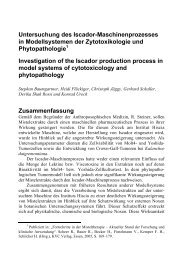Documentation of published clinical trials and ... - Institut Hiscia
Documentation of published clinical trials and ... - Institut Hiscia
Documentation of published clinical trials and ... - Institut Hiscia
Create successful ePaper yourself
Turn your PDF publications into a flip-book with our unique Google optimized e-Paper software.
Quality <strong>of</strong> Life / Pain 3.5<br />
Grossarth-Maticek R., Kiene H., Baumgartner S.M., Ziegler R. (2001) Use <strong>of</strong> Iscador, an extract<br />
<strong>of</strong> European mistletoe (Viscum album), in cancer treatment: prospective nonr<strong>and</strong>omized <strong>and</strong><br />
r<strong>and</strong>omized matched-pair studies nested within a cohort study. Alternative Therapies 7 (3), 57–78.<br />
Study design<br />
Design R<strong>and</strong>omised, prospective long-term, matched-pair technique.<br />
Patients 56 matched pairs <strong>of</strong> patients with different tumours.<br />
Treatment The patients in the Iscador group received an individual therapy with<br />
different doses <strong>and</strong> types <strong>of</strong> s.c. applied Iscador. The control group with<br />
matched patients did not receive any type <strong>of</strong> mistletoe treatment.<br />
Length <strong>of</strong> study 1973–1998.<br />
Measurement Self-regulation (Score 1 to 6) according to Grossarth-Maticek measured<br />
using questionnaires with graded answers.<br />
Most important results<br />
The self-regulation index is a measurement <strong>of</strong> individual activity to achieve well-being, inner<br />
balance, adapted motivation, a feeling <strong>of</strong> competence <strong>and</strong> safety <strong>and</strong> overcoming <strong>of</strong> stress<br />
situations. Two separately studied matched-pair groups (39 <strong>and</strong> 17 pairs), in which the Iscador<br />
treatment was prospectively r<strong>and</strong>omly recommended to one partner <strong>of</strong> the pair, showed an<br />
increase in the values for self-regulation after a 3-month treatment with Iscador from 3.41 to<br />
3.87 <strong>and</strong> 2.92 to 3.70 respectively, whereas the values in the control group sank from 3.85 to<br />
3.62 respectively increased only marginally from 2.87 to 2.99. The change in the value for selfregulation<br />
for the Iscador group was significantly different to that <strong>of</strong> the control group (56 pairs,<br />
p = 0005)<br />
For further results see 5.2.5, 5.2.6, 5.3.1.2, 5.3.3.3, 5.4.5.<br />
4.0<br />
3.5<br />
3.0<br />
2.5<br />
Self-regulation Index<br />
at the beginning <strong>of</strong> therapy<br />
3 months after beginning <strong>of</strong> therapy<br />
Iscador control Iscador control Iscador control<br />
Study 1 Study 2 Study 1+2<br />
Fig. 1: Changes in the values for the self-regulation index for tumour patients due<br />
to a 3-month treatment with Iscador in comparison to matched control patients<br />
without Iscador (Study 1: 39 matched pairs, Study 2: 17 matched pairs) (graph<br />
according to Grossarth-Maticek et al. 2001).<br />
© Verein für Krebsforschung, CH-4144 Arlesheim




